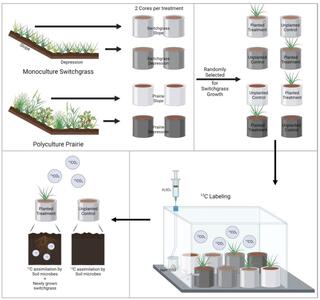Prairie soil clings to carbon on slopes

Objective
Both monoculture switchgrass and restored prairie are key perennial bioenergy sources because of two key characteristics: their high carbon sequestration, and their ability to grow on marginal lands. This study analyzed the effect of topography and cropping systems on plant growth and soil carbon gains.
Approach
Researches sampled depression and slope soils from both prairie and switchgrass systems. Half of the soil cores were planted with switchgrass; the rest were unplanted. Researchers exposed plants to carbon-13 and traced the isotope’s movement through the plant and its roots. Harvested, ground plants were analyzed for total carbon, and soil cores were assessed via X-ray computed tomography. The soil surrounding the roots was removed and assessed.
Results
Belowground carbon content was higher in the switchgrass grown in prairie soil. Switchgrass grown in prairie soils situated on slopes also had higher biomass carbon in both the above- and belowground plant growth as compared to switchgrass grown in the prairie soil of depressions. Prairie systems consistently outcompete monoculture systems in plant diversity, carbon content, and microbial carbon content.
Impact
This study demonstrates that future research should seriously consider perennial systems, especially prairie, for bioenergy cropping on marginal lands unfit for food production.